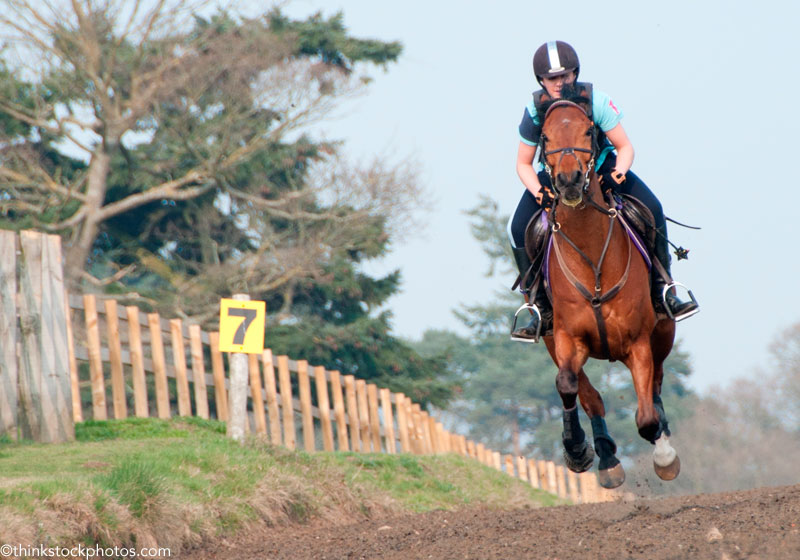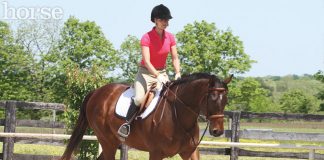
Fast riding is now a skill that must be learned by both horse and rider. And learn it you must if you want to compete in any of the jumping disciplines, keep your dressage horse moving forward, or condition your equine athlete.
Gait Analysis
The hand gallop and, in particular, the gallop differ from the canter in many ways. The canter comprises three beats: the outside foreleg and the inside hind leg hit the ground at the same time. The other two legs hit independently. This creates the three beats. The canter speed is an average 375 meters per minute. The hand gallop is a little bit more forward, clipping along at 400 to 450 mpm, but still maintaining the three beats of the canter.
Because the gallop requires a further extension of the limbs it is a four-beat gait, with every leg hitting the ground independently. The gallop is anything above 450 mpm, depending upon the ability of the horse.
“Some horses cannot gallop at all,” says Canadian Olympic event rider Mike Winter. “For example, top-level dressage horses can be loftier, with a bigger phase of suspension, and have a hard time galloping. It also depends upon a horse’s conformation.”
In the Sport
The hand gallop is used in lower levels of eventing and frequently in jumper competition. It is also used as a schooling exercise for dressage horses to create a more forward and expressive canter. The hand gallop is a good way to introduce the novice rider to the gallop.
Todd Karn, United States Equestrian Federation (USEF) “R” hunter and equitation judge, says that hand gallop on the flat isn’t required in under saddle hunter classes anymore.
“It used to be asked for to see which horse had a long smooth stride that would go forward and then pull up and be quiet,” he says. “It’s [typically] not asked for today because it incites riots and bucking. Riders aren’t comfortable working with pace anymore. In the old times, horse shows were out in the open and you had to gallop. Rings now are smaller and the courses demand a lot of control. You will see the hand gallop asked for in equitation-over-fences classes, usually toward the last fence to test if the rider’s eye can work with more pace than just the jumping canter. This is put in to keep up that old skill. Eventually after equitation, the riders go on to become show jumpers and must know how to jump against the clock. The hand gallop really teaches riders to be able to jump with extra pace.”
The gallop is where event riders shine. In fact, they do most of their cross-country work at the gallop.
“We are required to gallop at the high level of eventing,” Mike says. “Preliminary eventing speed is set at 520 mpm, Intermediate speed is at 550 and Advanced speed is 570.”
Proper training that incorporates galloping is also a great way to get horses fit. Sustained heart rate from galloping is necessary to prepare horses for eventing and other fast sports, such as endurance riding. Galloping, when done correctly, can also help develop stronger soft tissues.
The Correct Position
Both gaits are ridden in the two-point position, which requires a more closed hip angle, about 30 degrees, at all disciplines. But there are really no hard and fast rules on how closed the hip angle must be for eventing.
“To me it’s a very personal thing,” Mike says. “The galloping position is different for everybody. I stand higher and in a more open position than most riders do. Philip Dutton stays up quite straight, and Karen O’Connor is almost flat over her horse. I think this is because of different body types, whether they are long in the torso or long in the thigh. The most important thing is that your hands are low, that the foundation of the position is in your lower leg and that you’re not using the horse’s mouth for balance. The big difference between the galloping position and sitting is that your leg is the foundation of your position in the gallop and hand gallop. Your leg should be just underneath your body. This is because the technical aspect of eventing requires that we jump at great speed over different obstacles. If your leg is too much in front, you might fall back and catch the horse’s mouth. If your leg is under your body, you can create impulsion and steer; you have more control.”
The reins are held in the usual way in the hand gallop. In the gallop you can hold your reins in either the half bridge or the full bridge. In the half bridge you stretch one end of the rein across the horse’s neck so that you’re holding two pieces of leather in one hand. For the full bridge you stretch both ends of the rein across the horse’s neck so that both hands are holding two pieces of leather; the reins will be stretched across the horse’s crest instead of hanging in a loop alongside the neck.
“Riders who are inexperienced in their balance can push their hands into the full bridge. The bridges are also very useful tools in terms of safety,” Mike says. “If a horse were to stumble, the bridge can catch you from falling because your arms won’t collapse on either side of the horse’s neck. Instead, the bridge will catch you.”
Starting and Stopping—Keeping Control
We’ve all seen the way the cowboys start their gallop in the movies, with a “yee haw” and a kick, and away they go. This galloping style is a Hollywood urban myth. Racehorses aside, for the English rider, the best way to begin a gallop is to build it up slowly. This is because some horses can get high on the speed. A fast start can undo the hard work and training you’ve put in to get your horse obedient and listening to your aids.
“When we’re eventing and we leave the start box, I leave at a trot, then a canter, then a hand gallop and then a gallop. You make sure the horse is still listening and rideable,” Mike says. “Even within the gallop you need that control so that you can vary the speed and stride. Speed and length of stride are two different things. You can go very fast and jump the jump without slowing down very much. But if a horse can’t package (shorten or lengthen) his stride, he isn’t safe. Every kind of jump requires some kind of packaging of the stride. For instance, a steeplechase will not require the same as a downhill combination.”
Packaging of the stride goes back to your work on the flat. If your horse listens to your half-halts you can regulate his stride.
Stopping comes from control also learned during flat work. Hours spent over time training your horse to be responsive to the aids is going to pay off in safety, controllability and enjoyment.
“There isn’t any one skill or trick,” Mike says. “Don’t panic if you’re getting out of control, just relax and try to get your horse to slow down gradually.”
For the hand gallop, start from a normal canter on the flat, come out of the saddle in a two-point and encourage your horse to move forward.
“Close your lower leg and ask your horse to go smoothly forward, lengthen his stride and move his speed up a gear,” Todd says. “To come back, use your body and seat and try not to be rough with your hands. A quiet ‘whoa’ is fine in equitation, hunters and jumpers.”
Although the hand gallop is not normally used in hunter-under-saddle classes, it might be asked for in general schooling or breed shows. Remember, the judge isn’t looking for an all out gallop. Hand gallop means the horse is still “in hand” or in control. Lengthening the stride and slightly increasing the speed is what you’re shooting for.
“Look at it this way,” Todd says. “A canter is 10 mph. The hand gallop is about 14 to 16 mph. You’re not doubling the speed, you’re just adding half as much.”
When jumper riders gallop in a class against the time they treat the gallop the same as the hand gallop but a little bit quicker, yet not so fast that they pull the fence down. To practice this, Todd says to gallop toward the fence and then slow down or “balance up” a few strides in front of the fence to allow your horse to get his legs up underneath him to jump.
The bottom line is that your horse’s foundation must be solid before you start the hand gallop or gallop. Your horse must listen to your aids, be rideable and obedient. “Riding at speed does not mean running as fast as you can in gay abandon,” Mike says. “If you care about your horse, and are invested in his life with you and your harmonious relationship, then you should take these gaits very seriously and understand that they are exercises in communication, training and enjoyment.”






Excellent explanation of the gallop and hand gallop, thank you!
I honestly did not know much about hand galloping before, so this article halped a lot.
very helpful! and AMEN! that 1st paragraph is so sad but so true!
Great article~
Wonderful information! Yesterday I went into a hand gallop and did absolutely horrible. Reading this helped me realize what I did wrong. Thank you!
I just went to the National show @ Lake Erie on Sunday May 3rd (I think) and they hand galloped. I understand the term more now. Thanks!
Fanastic article!
I am learning to event, and my experienced friend and I were on a trail in an open field they use to practice hand-galloping. They got me to try it, and this article has really helped me understand what to do in the future so my hand-gallop is not out-of-control.
Thanks!
good article
Very informative article…
Great info!!